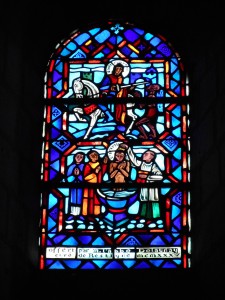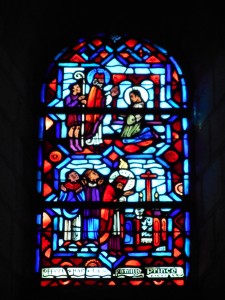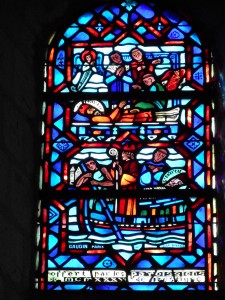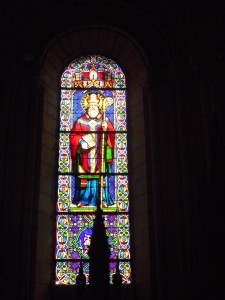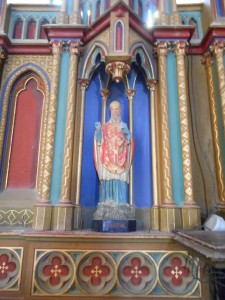En 862, le roi Charles le Chauve établit un acte à la demande de la communauté de Saint-Martin de Tours énumérant ses possessions. Parmi elle se trouve Restiniacus (Restigné). Il devait y avoir une église et des chapelles sur ce site. La possession est confirmée en 903 et en 916 par Charles le Simple. En 1177, le pape Alexandre III confirme dans une bulle les biens de Saint-Martin de Tours et mentionne « Restiniacus cum ecclesia Sancti Martini »
La nef est en partie la plus ancienne et date du début XIè siècle. Elle est couverte en charpente, refaite vraisemblablement au XVIè siècle. Au nord de la nef a été ajouté, au XIVè siècle, un collatéral restauré au XIXè siècle. Le choeur de deux travée, terminé par un chevet plat ajouré de deux grandes fenêtres en plein cintre est de la fin du XIIè siècle ou du début du XIIIè. Il est couvert de voûtes angevines sur ogives et liernes.
Cette église abrite quatre vitraux figurant un baptême de saint Martin et une charité, un saint Martin évêque et une charité, saint Martin ordonné exorciste par saint Hilaire, et la mort de saint Martin. Elle abrite également une statue de saint Martin évêque.
Le premier vitrail est offert par l’abbé Delaunay, curé de Restigné, en 1935 présente dans le registre supérieur une charité de saint Martin et dans le registre inférieur un baptême de saint Martin. Dans cette charité, saint Martin, en cavalier romain nimbé, coupe son manteau à l’aide de son épée. Le pauvre à une attitude de prière, il a les mains croisées et les tends vers saint Martin. Dans la scène du baptême, saint Martin est nimbé, il est nu dans un baptistère, il a les mains en croix sur son torse. Un évêque, habillé en blanc, le béni. Deux hommes regardent la scène. Dans les deux scènes, le nom de saint Martin est écrit dans l’auréole.
Le deuxième vitrail est réalisé par J. le Breton, Gaudin, Paris, en 1935, offert à la paroisse par la famille Prince. Il n’a que trois personnages dans chaque registre du vitrail. Dans le registre supérieur Saint Martin est agenouillé, nimbé. Il est vêtu simplement, en blanc. Saint Hilaire tend les mains vers lui, comme pour le bénir. Derrière lui, un autre personnage, habillé de couleurs violettes, tient la crosse de l’évêque. Dans le registre inférieur, saint Martin est présenté en évêque, agenouillé devant un autel, avec deux personnages en prière derrière lui.
Le troisième vitrail est réalisé par J. le Breton, Gaudin, Paris, en 1935, offert par les paroissiens en 1935. Il est divisé en deux registres. Le registre supérieur présente la mort de saint Martin, avec saint Martin en évêque, habillé en orange, allongé devant trois disciple en prière. On voit un ange en prière également à la gauche du registre. Le registre inférieur présente le rapt du corps de saint Martin par les Tourangeaux. Un jeune évêque, mitré, tenant une crosse et vêtu de orange, se tient devant la barque dans laquelle se trouve saint Martin allongé, avec un moine en prière et une homme qui dirige la barque. On distingue une église à la gauche du registre. Les auréoles figurent le nom de « St Martin ».
Le dernier vitrail est donné par Monsieur Louis Aubin de Louy en 1855 présente saint Martin évêque , nimbé et mitré, vêtu d’une chasuble rouge avec une croix bleue et dorée, portant une dalmatique verte et une aube bleue. Il tient un livre dans la main droite et sa crosse dans la main gauche. On devine qu’il est écrit dans l’auréole « Sanctus Martinus ». Une charité de saint Martin est présente dans le registre inférieur du vitrail. Saint Martin est représenté en cavalier, il est nimbé. Il coupe son manteau pour le partager avec un pauvre. Le pauvre est debout, il s’appui sur un bâton et tend la main vers saint Martin. Le fond est bleu avec une plante à gauche.

Une statue de saint Martin se trouve dans une niche, à gauche du maître-autel de l’église Saint-Martin de Restigné. Saint Martin est représenté en évêque, vêtu d’une chasuble rouge avec des décors dorés, une dalmatique blanche, une aube bleue et des gants bleus. Il semble faire une geste de bénédiction de la main droite mais l’index et le majeur ont disparu.
L’église est classée Monument Historique en 1999 : PA00097936
In 862, King Charles the Bald drew up a deed at the request of the community of Saint-Martin de Tours listing its possessions. Amongst them is Restiniacus (Restigné). There must have been a church and chapels on this site. Possession was confirmed in 903 and in 916 by Charles the Simple. In 1177, Pope Alexander III confirms in a bull the property of Saint-Martin of Tours and mentions « Restiniacus cum ecclesia Sancti Martini ».
The nave is partly the oldest and dates from the beginning of the 11th century. It is covered with a roof frame, probably rebuilt in the 16th century. To the north of the nave, a side aisle was added in the 14th century and restored in the 19th century. The two-bay choir, finished by a flat chevet with two large round-headed windows, dates from the end of the 12th century or the beginning of the 13th. It is covered with Angevin vaults on ogives and liernes.
This church has four stained glass windows depicting a baptism of Saint Martin and a charity, a Saint Martin bishop and a charity, Saint Martin ordered to be exorcised by Saint Hilaire, and the death of Saint Martin. There is also a statue of St Martin the bishop.
The first stained glass window was donated by Abbé Delaunay, the parish priest of Restigné, in 1935. The upper register shows the charity of Saint Martin and the lower register shows the baptism of Saint Martin. In this charity, Saint Martin, as a nimbed Roman cavalryman, cuts his cloak with his sword. The poor man is in an attitude of prayer, his hands are folded and he is holding them out to Saint Martin. In the baptism scene, St Martin is nimbed, naked in a baptistery, with his hands crossed on his chest. A bishop, dressed in white, blesses him. Two men look on. In both scenes, St Martin’s name is written in the halo.
The second stained glass window was made by J. le Breton, Gaudin, Paris, in 1935, given to the parish by the Prince family. It has only three figures in each register of the window. In the upper register Saint Martin is kneeling, nimbed. He is dressed simply in white. Saint Hilaire holds out his hands to him, as if to bless him. Behind him, another figure, dressed in purple, holds the bishop’s crook. In the lower register, Saint Martin is shown as a bishop, kneeling before an altar, with two figures praying behind him.
The third stained glass window was made by J. le Breton, Gaudin, Paris, in 1935, donated by the parishioners in 1935. It is divided into two registers. The upper register shows the death of St Martin, with St Martin as a bishop, dressed in orange, lying before three praying disciples. An angel is also seen praying to the left of the register. The lower register shows the abduction of St Martin’s body by the Tourangeaux. A young bishop, mitred, holding a crosier and dressed in orange, stands in front of the boat in which Saint Martin is lying, with a monk in prayer and a man steering the boat. A church can be seen to the left of the register. The halos show the name « St Martin ».
The last stained glass window was donated by Mr Louis Aubin de Louy in 1855 and shows St Martin as a bishop, nimbed and mitred, wearing a red chasuble with a blue and gold cross, a green dalmatic and a blue alb. He holds a book in his right hand and his crosier in his left. One can guess that the halo reads « Sanctus Martinus ». In the lower register of the window there is a charity of Saint Martin. Saint Martin is depicted as a rider, wearing a nimbus. He cuts off his cloak to share it with a poor man. The poor man is standing, leaning on a stick and reaching out to Saint Martin. The background is blue with a plant on the left.
A statue of Saint Martin is in a niche to the left of the high altar of the church of Saint Martin in Restigné. Saint Martin is depicted as a bishop, wearing a red chasuble with gold decorations, a white dalmatic, a blue alb and blue gloves. He seems to be making a gesture of blessing with his right hand, but the index and middle fingers have disappeared.
The church was listed as a historical monument in 1999: PA00097936

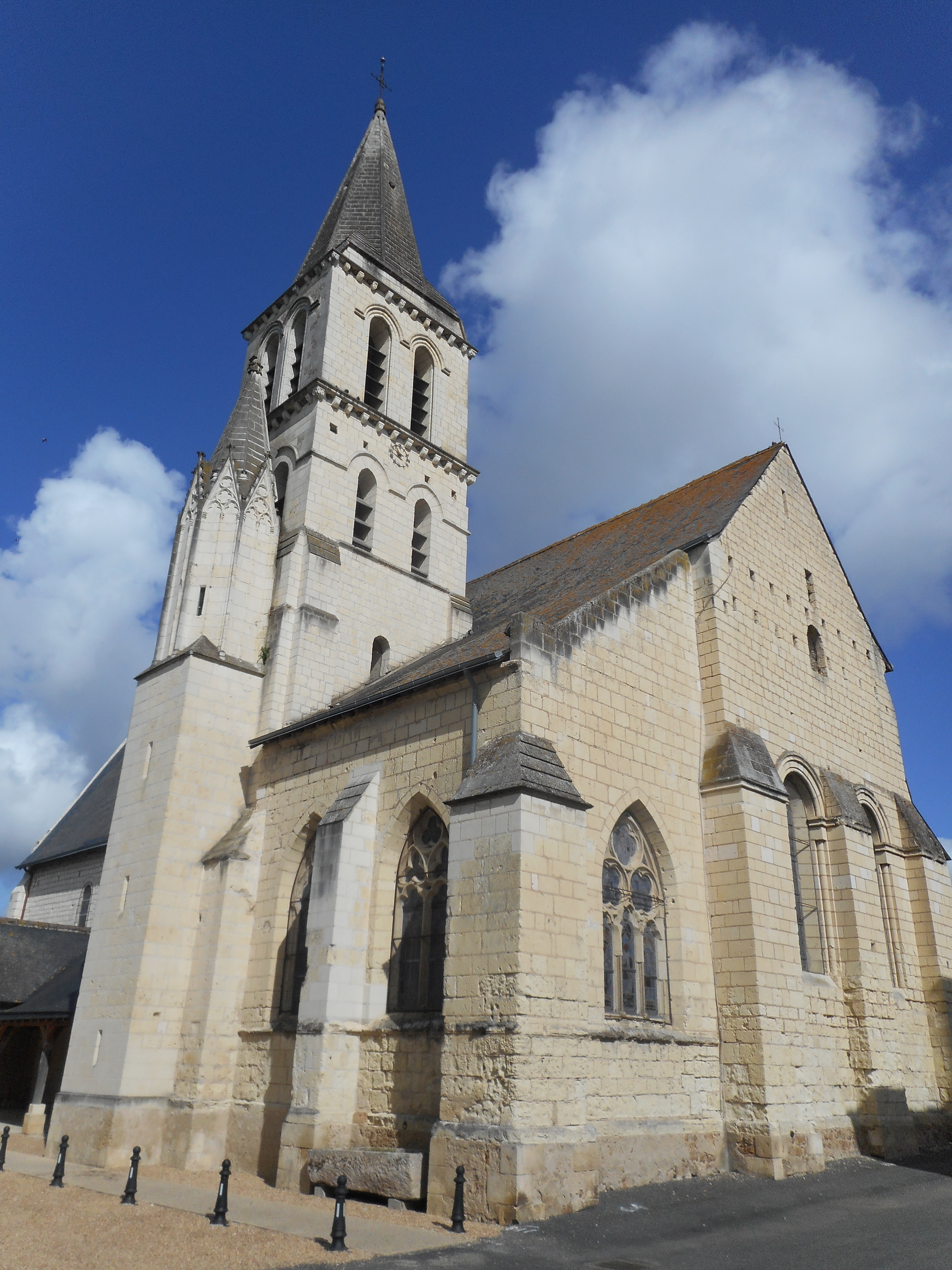 "/>
"/>
